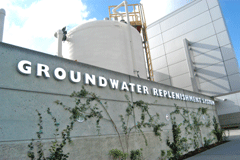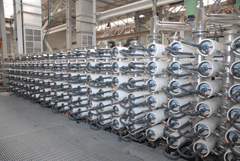From Toilet to Tap
Air Date: Week of July 25, 2008

Orange County will soon use purified wastewater to replenish sinking groundwater. (Photo: Orange County Water District)
Los Angeles recently announced it will begin recycling sewage waters into drinking water using advanced treatment. LA is following the lead of Orange County, CA, which earlier this year opened the most advanced such system in the country. Living on Earth’s Ingrid Lobet reports in this piece.
Transcript
CURWOOD: Shortages of water in Southern California had officials looking in some unlikely—and perhaps unsavory—places.
[SOUND OF TOILET FLUSHING]
CURWOOD: The squeamish call it ‘toilet to tap.’ The correct term is ‘indirect potable water reuse.’ That’s a mouthful. And recently, 2.3 million people in Orange County California began quenching their thirst with it. Living on Earth’s Ingrid Lobet reports.
LOBET: It's the basic tenet of public health—keep your water and sewer separate. Yet Orange County water and sewage treatment officials have found the closer they work together, the better.
WILDERMUTH: Because of growing population, we knew that we need to put more water in the groundwater basin. And so 10, 13 years ago, we started looking around.

In reverse osmosis, water molecules are forced through plastic film. (Courtesy of Orange County Water District)
WILDERMUTH: So you had one water agency needing water. You had a sanitation district that was going to have to build another pipe to dispose of more water. So they came together and said ‘why don't we take that water, purify it, and then you won't have to build the ocean outfall.’
LOBET: It helped the decision along that the cost of electricity to clean wastewater was less than pumping water over the mountains from northern California, and also less than getting the salt out of seawater.
[SOUND OF FLOWING WATER]
HELLEBRAND: This water now is what will be sent over to the water districts. So we're at the end of the water process.
LOBET: Now, more than a decade later, Ingrid Hellebrand of the Orange County Sanitation District points with pride at her finished product—strained, settled, aerated and skimmed into a goldish but clear liquid. Hellebrand calls the stuff she deals with everyday ‘water.’ Does she really think of it as water?
HELLEBRAND: Yeah, it’s, it’s water!
LOBET: Well, 99.9 percent water. There is .1 percent of something else.
HELLEBRAND: When you flush the toilet, when you brush your teeth, the water just goes away. And nobody really thinks about where away is, but that’s where I work—where ‘away’ is. And the school kids come through, and they're kind of looking for that yuck factor. And by the time they get to the end of the process and they see that the water is so clean—you almost want to drink it! (laughs)
LOBET: And from here, the end of the sewage treatment process, it gravity-drains to the water utility, right next door. There, three things happen. None by itself is unique or too remarkable but taken together, and used on wastewater, it's the largest project of its kind in the world. First the water is sucked up into thousands of stringy straws with perforated sides.
[SOUND OF MICROFILTRATION]
LOBET: Bugs like protozoa and bacteria in the water can't fit though the holes. So every 22 minutes the airflow reverses to blow instead of suck, to clean the holes. The impurities are promptly sent back across the property line to the sewage treatment plant. Ron Wildermuth of the Water District loves the sound.
WILDERMUTH: It's like an orchestra.
LOBET: Music to your ears?
WILDERMUTH: Yes it is! (laughs)
LOBET: Next, the water passes though chambers for reverse osmosis. That means the water molecules are actually forced, under intense pressure, through a sheet of plastic. Wildermuth says not much besides tiny water molecules can pass through.
WILDERMUTH: If you size a water molecule the size of a tennis ball, your pharmaceuticals, hormones, pesticides—would be the size of a soccer ball. Okay? A virus would be the size of a tractor-trailer truck. So basically we’re physically not allowing viruses, uh, fertilizers, pesticides, hormones, or pharmaceuticals to get through because they can't get through the plastic sheet.
LOBET: Last, the water is exposed to ultraviolet light and mixed with peroxide. That zaps two compounds that manage to get this far for final cleaning. The engineers here at the water utility brought all this new equipment online over the last three months. The day before my visit had been a milestone. For the first time they'd injected their new purified water underground. William Dunivin is in charge.
DUNIVIN: To see it all come together after so many years it’s like, I can't explain it. And just the fact that it's such a, a timely event for the world to see this. I mean, with water becoming such an issue throughout the world. And this is a viable way to do it, and safely.
LOBET: A steady stream of visitors from around the globe tour the project. At home, it's been the focus of an intense public relations, okay, public education campaign. Again, Ron Wildermuth.
WILDERMUTH: We thought we could convince the people this was a good idea, and we did.
LOBET: How did you do that?
WILDERMUTH: Face to face talks for ten years to everybody that would listen. We talked to the historical society. We talked to the chambers. We talked to the flower committee. If there was a group, we talked to them.

Orange County will soon use purified wastewater to replenish sinking groundwater. (Courtesy of Orange County Water District)
WILDERMUTH: Very good water.
LOBET: For those not persuaded by the positive, consider this: many of us are already drinking water that was discharged as treated sewage into a river, and then tapped and purified downstream.
WILDERMUTH: Las Vegas puts like 200,000 gallons of wastewater in Lake Mead every day. And that comes down to us. It’s nothing new.
LOBET: But we haven't been talking that much about it.
WILDERMUTH: You're darn right we haven't. But, you know, it's a fact of life.
LOBET: For Living On Earth, I'm Ingrid Lobet in Fountain Valley, California.
Links
Groundwater Replenishment System
Living on Earth wants to hear from you!
Living on Earth
62 Calef Highway, Suite 212
Lee, NH 03861
Telephone: 617-287-4121
E-mail: comments@loe.org
Newsletter [Click here]
Donate to Living on Earth!
Living on Earth is an independent media program and relies entirely on contributions from listeners and institutions supporting public service. Please donate now to preserve an independent environmental voice.
NewsletterLiving on Earth offers a weekly delivery of the show's rundown to your mailbox. Sign up for our newsletter today!
 Sailors For The Sea: Be the change you want to sea.
Sailors For The Sea: Be the change you want to sea.
 The Grantham Foundation for the Protection of the Environment: Committed to protecting and improving the health of the global environment.
The Grantham Foundation for the Protection of the Environment: Committed to protecting and improving the health of the global environment.
 Contribute to Living on Earth and receive, as our gift to you, an archival print of one of Mark Seth Lender's extraordinary wildlife photographs. Follow the link to see Mark's current collection of photographs.
Contribute to Living on Earth and receive, as our gift to you, an archival print of one of Mark Seth Lender's extraordinary wildlife photographs. Follow the link to see Mark's current collection of photographs.
 Buy a signed copy of Mark Seth Lender's book Smeagull the Seagull & support Living on Earth
Buy a signed copy of Mark Seth Lender's book Smeagull the Seagull & support Living on Earth

